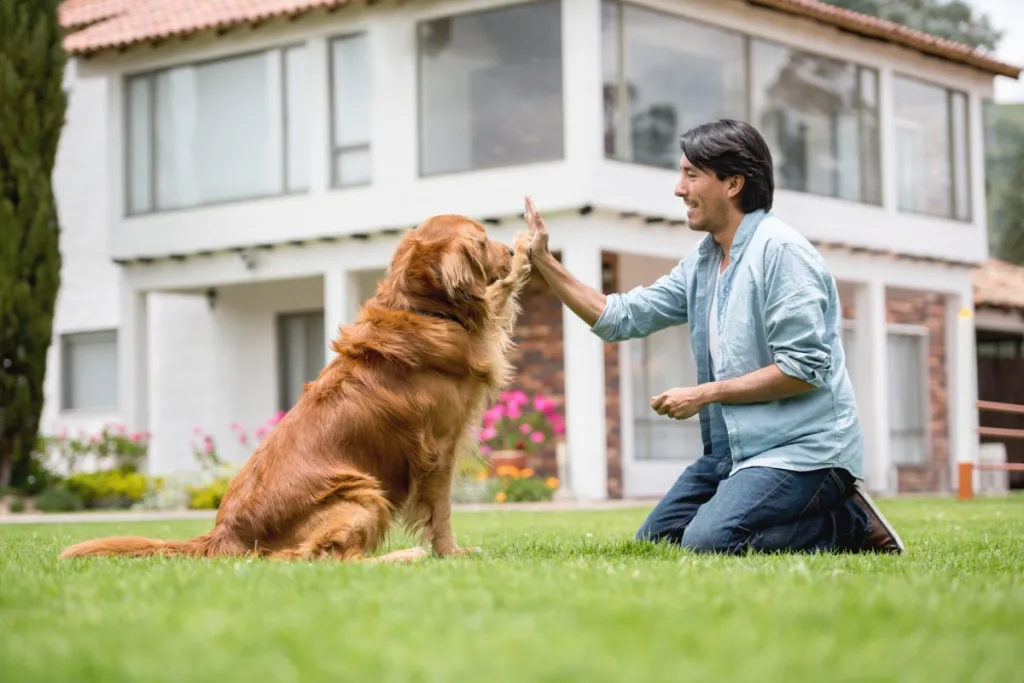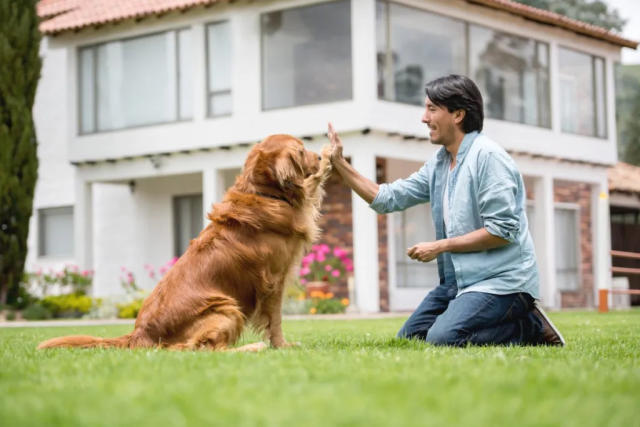Dog training can include non-food rewards such as praise, petting, favorite toys, or games in addition to food treats, which are especially effective due to most dogs being highly food-motivated. It is important to find treats that are enticing and irresistible to your pet through experimentation.
Additionally, using play and toys as training rewards is a great alternative for dogs that are not interested in treats. Building enthusiasm for rewards in non-food motivated dogs can range from various options such as food, toys, games, petting, praise, or even getting to jump on you.

Credit: dogtime.com
Using Food Treats In Dog Training
Dog training is an essential part of owning a pet, and using the right rewards is crucial for success. When it comes to training dogs, one of the most popular and effective methods is positive reinforcement. This involves rewarding desired behavior to encourage its repetition. While various types of rewards can be used, food treats are particularly effective due to their high motivation value for most dogs.
Types Of Rewards That Can Be Used
Apart from food treats, there are other types of rewards that can be used in dog training. These include:
- Praise: Dogs respond well to vocal praise, as it reinforces positive behavior and strengthens the bond between the dog and owner.
- Petting: Physical affection such as gentle petting and belly rubs can be rewarding for dogs and serve as motivation during training sessions.
- Toys: Some dogs are more motivated by play and toys rather than food treats. Using their favorite toy or a game as a reward can be highly effective in training.
Benefits Of Positive Reinforcement Training
Positive reinforcement training has numerous benefits for both dogs and owners. Some of these benefits include:
- Strengthens the bond: Using rewards like food treats promotes a positive and trusting relationship between the dog and owner.
- Encourages desired behavior: By rewarding desired behavior, dogs learn what is expected of them and are more likely to repeat it.
- Reduces stress: Positive reinforcement training focuses on rewarding good behavior rather than punishing inappropriate behavior, creating a less stressful learning environment for the dog.
- Increases motivation: Using rewards keeps dogs engaged and motivated during training sessions, making the learning process more enjoyable for both the dog and the owner.
Tips For Finding The Best Treats For Your Dog
Finding the right treats for your dog is essential to ensure effective training. Here are some tips to consider:
- Consider your dog’s preferences: Every dog has different tastes and preferences when it comes to treats. Experiment with different flavors and textures to find what your dog finds most enticing.
- Size and texture: Choose treats that are the appropriate size for your dog. Smaller treats are easier to handle and can be quickly consumed during training sessions. Additionally, consider the texture of the treat – some dogs prefer crunchy treats, while others prefer soft ones.
- Quality ingredients: Opt for treats made with high-quality ingredients to ensure your dog’s overall health and well-being.
- Training-specific treats: Look for treats specifically designed for training purposes. These treats are often smaller in size, low in calories, and can be easily broken into smaller pieces.
- Consider dietary restrictions: If your dog has any dietary restrictions or allergies, make sure to choose treats that align with their needs.
In conclusion, using food treats in dog training can be highly effective due to their high motivation value for most dogs. However, it is essential to consider other types of rewards as well, such as praise, petting, and toys. Positive reinforcement training has several benefits, including strengthening the bond between the dog and owner, encouraging desired behavior, reducing stress, and increasing motivation. When selecting treats for your dog, consider their preferences, size and texture, ingredient quality, training-specific options, and any dietary restrictions they may have.

Credit: www.amazon.com
Motivating Dogs Without Food
When it comes to dog training, food treats are often the go-to reward. However, not all dogs are motivated by food, and it’s important to have alternatives in order to effectively train these dogs. Using play and toys as training rewards can be a great way to motivate dogs that aren’t interested in treats. Not only does it make the training process enjoyable for your furry friend, but it also strengthens the bond between you and your dog. In this article, we will explore the benefits of using play and toys as rewards in dog training and provide some tips on how to introduce them to your training sessions.
Using Play And Toys As Training Rewards
Introducing play and toys into dog training sessions can be a fun and effective way to motivate your non-food oriented dog. Instead of relying solely on food treats, you can use their favorite toy or engage them in a game as a reward for their good behavior. This not only provides mental stimulation but also taps into their natural instincts, keeping them engaged and excited to participate in training. By using play and toys as rewards, you can make the training sessions more enjoyable for your dog while still reinforcing positive behavior.
Introducing Toys And Play In Dog Training
When introducing toys and play in dog training, it’s important to choose toys that your dog finds exciting and stimulating. Different dogs have different preferences, so it may take some trial and error to find the toys that work best for your furry companion. Start by finding a toy that captures their attention and brings out their natural playfulness. Use this toy as a reward during training sessions, only giving it to them when they successfully complete a command or exhibit good behavior.
It’s also important to establish clear rules for playtime during training. This will help prevent your dog from getting overexcited or distracted during training. Set specific playtime intervals and use cues that signal the start and end of playtime. By incorporating structure into play and training, you can create a positive and balanced training environment that ensures your dog is engaged and focused during training sessions.
Alternatives To Food Rewards
For dogs who are not motivated by food, it’s important to have a variety of alternative rewards to keep them motivated and engaged. Besides using play and toys, you can also explore other non-food rewards such as praise, petting, or even a favorite activity like going for a walk or playing fetch in the park. Every dog is unique, so it’s important to experiment and find the rewards that work best for your canine companion. By offering a mix of different rewards, you can keep your dog excited and motivated to learn and participate in training sessions.
In conclusion, using play and toys as training rewards is a great way to motivate non-food oriented dogs and make training sessions enjoyable for both you and your furry friend. By introducing toys and play, you tap into your dog’s natural instincts and provide mental stimulation, strengthening their bond with you. Remember to choose toys that your dog finds exciting, establish clear rules for playtime, and explore a variety of non-food rewards to keep your dog engaged and motivated. With these techniques, you can achieve effective and enjoyable training sessions with your dog.
Training A Non-food Oriented Dog
Some dogs simply aren’t motivated by food rewards. While most dogs tend to respond well to treats during training, there are those who need alternative forms of rewards to stay engaged and eager to learn. If you find yourself in this situation, don’t worry! There are plenty of other ways to reward your dog and make training an enjoyable experience for both of you. In this blog post, we’ll explore the importance of ensuring your dog is hungry for training, using high-value food rewards, and exploring non-food rewards like toys and praise. Let’s dive in!
Ensuring Your Dog Is Hungry For Training
To make training sessions more effective for a non-food oriented dog, it’s crucial to ensure they are hungry and motivated when you begin. If your dog has recently eaten a full meal, they may not be as interested in food rewards during training. Here are a few tips to ensure your dog is hungry and ready to learn:
- Time your training sessions before meals, when your dog is naturally more motivated by food.
- Take note of your dog’s feeding schedule and plan your training accordingly.
- Reduce the portion size of their meal before training, so they have an appetite for the rewards.
Using High-value Food Rewards
While your dog may not be food-oriented, it doesn’t mean they won’t respond to certain high-value treats. Experiment with different types of treats to find what your dog finds most irresistible. Here are some high-value food rewards that often work well:
- Real meat or fish treats
- Freeze-dried liver or chicken
- Peanut butter or cheese (in moderation)
Remember, these treats should be used sparingly and exclusively for training purposes to maintain their value. Reserve them for moments when your dog accomplishes a particularly challenging task or makes significant progress.
Exploring Non-food Rewards Like Toys And Praise
When food isn’t a strong motivator for your dog, it’s essential to explore alternative non-food rewards that they find appealing. Here are some non-food rewards that you can incorporate into your training sessions:
- Engaging toys: Find toys that your dog loves and reserve them exclusively for training. This will create excitement and anticipation when they see the toy come out during a session.
- Praise and petting: Dogs thrive on affection and attention from their owners. Verbal praise, gentle petting, and enthusiastic encouragement can be powerful rewards for a non-food oriented dog.
- Playtime: Incorporate short play sessions as rewards for successfully completing training tasks. This could involve a game of fetch, a fun tug-of-war session, or any other activity that your dog enjoys.
Remember, the key to successful training with non-food rewards is to make them exciting and enticing for your dog. You want them to look forward to these rewards and associate them with their training achievements.
Indirect Rewards In Dog Training
In dog training, non-food rewards can be just as effective as treats. Some dogs are motivated by praise, petting, or playtime with a favorite toy. Experimenting with different types of rewards can help you find what works best for your dog.
Understanding What Indirect Rewards Are
An indirect reward in dog training refers to a reward that is placed out in the environment, away from the trainer and the dog. The dog can only access this reward when the trainer gives a specific command or signal. It can be a toy, access to a favorite game or activity, or even affection and praise. The purpose of using indirect rewards is to create a sense of biological fulfillment for the dog, making the training process more enjoyable and rewarding.
The Benefits Of Indirect Rewards For Dogs
- Variety: Indirect rewards offer a wide range of options to keep the dog engaged and motivated during training sessions. This variety prevents boredom and ensures that the training remains exciting and enjoyable for the dog.
- Mental stimulation: By using indirect rewards, dogs are required to use their problem-solving skills and focus on accomplishing the task at hand. This mental stimulation helps to keep their minds sharp and active.
- Enhanced motivation: Indirect rewards tap into the dog’s natural instincts and desires, such as the desire to play or engage in activities they enjoy. By utilizing these rewards, trainers can boost the dog’s motivation to learn and succeed in training.
- Greater bond: Using indirect rewards allows trainers to interact with their dogs in a positive and exciting way. This strengthens the bond between the trainer and the dog, making the training experience more enjoyable for both parties.
- Positive association: Indirect rewards create a positive association with training for the dog. Instead of relying solely on food treats, dogs learn to associate training sessions with a range of enjoyable experiences, making them more eager to participate.
Implementing Indirect Rewards In Training
To ensure effective implementation of indirect rewards in dog training, trainers should:
- Identify the dog’s preferences: Understand what activities or rewards the dog finds most enticing, whether it’s playing with a specific toy or receiving praise and affection.
- Establish clear cues: Use commands or signals that indicate when the dog can access the indirect reward. This helps the dog understand the connection between certain behaviors and the desired outcome.
- Gradually introduce the rewards: Start by providing access to the indirect reward immediately after the desired behavior is performed correctly. Over time, increase the difficulty level to challenge the dog and reinforce the training.
- Maintain consistency: Ensure that the rules surrounding the use of indirect rewards remain consistent throughout the training process. This helps the dog understand and anticipate the reward, promoting focused and consistent behavior.
- Keep sessions fun and engaging: Incorporate play, games, and other enjoyable activities into training sessions to keep the dog excited and motivated. This makes the learning experience more positive and encourages the dog to actively participate.
By utilizing indirect rewards in dog training, trainers can create a rewarding and enjoyable learning experience for their furry companions. With the wide range of options available, dogs can stay engaged, motivated, and mentally stimulated throughout the training process.
Building Enthusiasm For Rewards
Building enthusiasm for rewards in dog training goes beyond just using food treats. Non-food rewards such as play, toys, praise, and petting can be equally effective in motivating dogs during training sessions. Experimenting with different types of rewards will help find what works best for your pet and keep them engaged in the training process.
ng to jump on you, etc., are all potential rewards that can be used to build enthusiasm during dog training. By providing a diverse range of rewarding options, you can keep your dog engaged and motivated to learn. Using food as a reward during training is a common and effective method. Most dogs are highly food-motivated, making treats an enticing incentive. Experiment with different types of treats to find out what works best for your pet. Ensure that the treats you choose are irresistible to your dog, making them eager to perform the desired behaviors. Toys and games can also serve as great rewards for dogs who may not be interested in food treats. Using play and toys as training rewards can be an excellent way to motivate your dog. Introduce toys and play as part of your dog’s training to keep them excited and engaged. It is important to ensure that your dog sees toys as a valuable and rewarding item. In addition to food and toys, praise and petting can be powerful rewards. Dogs thrive on positive reinforcement, and verbal praise or physical affection can be very rewarding for them. Ensure that the praise is enthusiastic and genuine to convey your appreciation for their efforts. Petting can also be used as a reward during training, as most dogs enjoy physical contact and affection from their owners. By incorporating a variety of rewarding options into your training sessions, you can ensure that the training remains fun and exciting for your dog. Dogs are individuals with different preferences, so it’s essential to find what motivates them the most. As you experiment and discover what rewards your dog responds to best, you’ll be able to build enthusiasm and create a positive learning environment.
Credit: www.yahoo.com
Frequently Asked Questions On Dog Training And Non-food Rewards
What Can Be Used As A Reward During Dog Training?
Rewards during dog training can include food treats, praise, petting, or a favorite toy or game. Food treats are especially effective as most dogs are highly food-motivated. Experiment to find the treats that work best for your pet. Using play and toys as rewards is also a great motivator for dogs not interested in treats.
How Can I Motivate My Dog Without Food?
Motivating your dog without food can be done by using play and toys as training rewards. Start by introducing toys and play to your dog’s training, making it fun and engaging. Ensure your dog is hungry for training sessions and use very high-value food rewards if needed.
Experiment to find what motivates your dog the most, whether it’s toys, pats, praise, or other forms of positive reinforcement.
How Do You Train A Non Food Oriented Dog?
To train a non-food oriented dog, ensure your dog is hungry for training sessions. Use high-value food rewards or try using toys, pats, and praise as rewards. Start by tossing special food on the floor and click with a clicker when your dog eats them.
Experiment to find what motivates your dog best.
What Is Indirect Reward In Dog Training?
Indirect reward in dog training is a reward placed in the environment that the dog can access when given a cue. It creates a sense of biological fulfillment for the dog.
Conclusion
When it comes to dog training, non-food rewards can be just as effective as treats. Using play and toys as rewards can motivate dogs that aren’t interested in food. Additionally, high-value food treats and favorite toys can work wonders in training a non-food oriented dog.
The key is to find what motivates your pet and experiment with different rewards. With patience and consistency, you can train your dog successfully without relying solely on food. So, get creative and explore a variety of rewards to make training a fun and enjoyable experience for both you and your furry friend.







